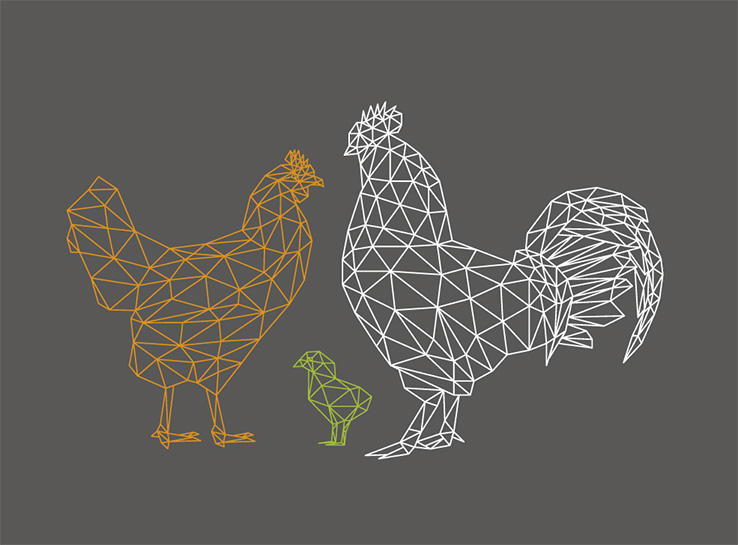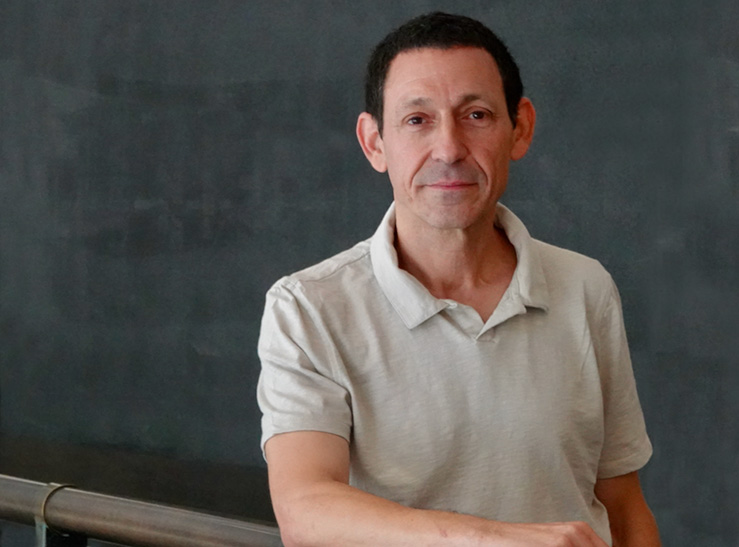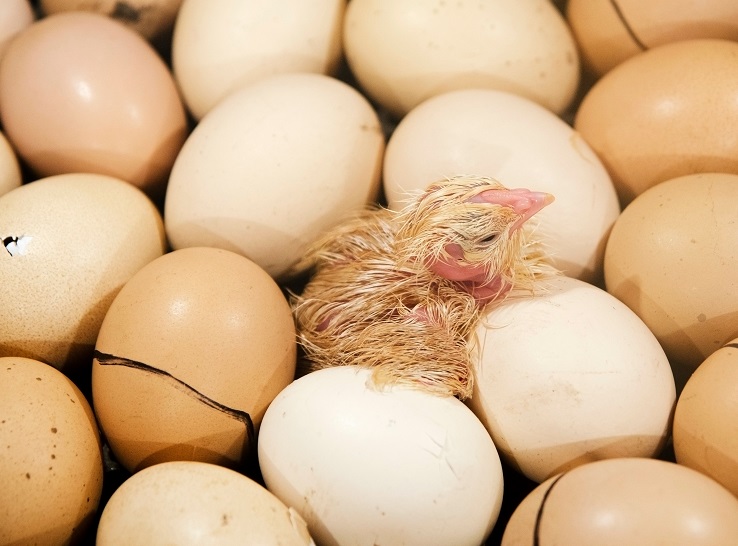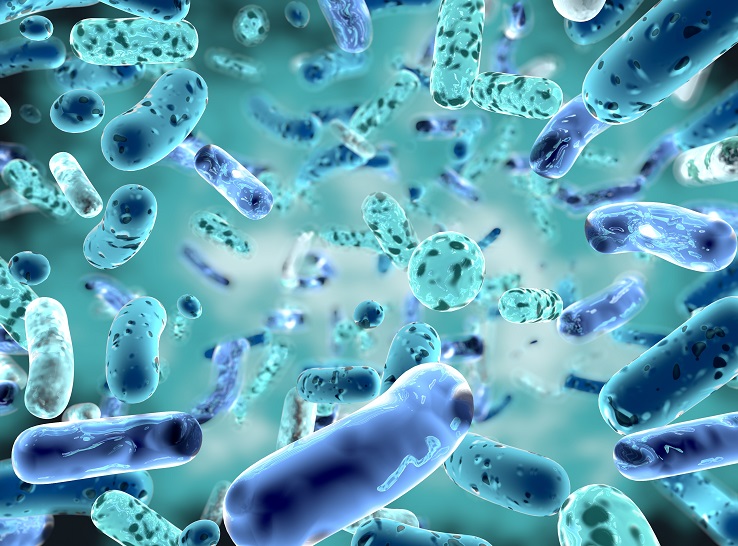The keynote address of the 2023 Poultry Science Association conference featured Yuval Cinnamon, PhD,* an Israeli embryologist leading a team of scientists that developed the first layer flock that produces females only. More significantly, the technology could put an end to culling 7 billion male chicks each year. Modern Poultry editor Joseph Feeks talked with Cinnamon about the technology, its impact on the industry and how soon it might be available.
MP: Dr. Cinnamon, you mentioned earlier that you’re not a “chicken guy” — that you’re actually an embryologist. How did you get involved with poultry?
Cinnamon: Yes, my background comes from basic science — embryology — but I’m becoming a poultry guy. Over the past 8 years, I’ve learned quite a lot about the industry because I had good mentoring — plus a lot of curiosity in order to learn the issues and the problems of the poultry industry.
From the very beginning, when we started worrying about the problem of culling day-old male chicks, it was clear to me that in order to provide a viable and a practical solution to the industry, I needed to understand the industry deeply. Because otherwise, it will not be adopted. What are the poultry industry’s needs? What are its requirements? What are the financial incentives?
And from a practical point of view, I liked promoting animal welfare issues combining them with economic incentives to the industry. That was the goal.
MP: Eight years ago, when you first got involved with this project, what was your reaction when you learned that the world layer industry sacrifices some 7 billion male chicks a year?
Cinnamon: I was totally amazed. Eight years ago, I knew nothing about the culling of day-old male chicks. I wasn’t aware about this problem, nor did I know about the previous attempts to solve it. It seemed to be the challenge I was looking for.
MP: When you look at 7 billion culls, there’s obviously welfare concerns associated with that statistic, but I imagine that adds up to a huge economic challenge for the layer industry as well.
Cinnamon: It is. It’s estimated that for each culled male there is a lost value of US$1. And that’s a huge amount of money — money that is basically wasted due to the energy losses for the need to incubate the male eggs, plus the staffing required to manually sort and cull the males, and, clearly, to dispose of the huge number of dead males.
It also poses a major sustainability issue. Again, energy, waste and the need to dispose of the males, which is also harming the environment.
MP: And the males account for what percentage of production?
Cinnamon: 50%.
‘Clearly unsustainable’
MP: Let’s talk about where the layer industry is today. What are the most common ways of sexing eggs?
Cinnamon: Currently, there is no practical solution. There’s no automated way to do it. Males are sorted manually from the females and are culled.
In Europe, they are committed to ending this practice. In Germany and in France, it is already illegal to kill the male chicks. They have some kinds of sorting technologies which are very expensive and also very inaccurate. But since they have a law that bans the culling, they must use them, and they are losing huge amounts of money. Hatcheries in the industry are suffering a lot. They are closing the hatcheries in Germany.
Because they cannot kill the males, by law, and because the sorting technologies are inaccurate, there are two side effects. First, they [mistakenly] kill [wanted] females, because the sorting isn’t accurate. The second problem is that they hatch males, but they cannot kill them. So what do they do with them? They are either rearing them, which isn’t efficient, and/or they ship them to the few countries that have a market for males. This is clearly unsustainable.
MP: Your team is taking a genetic approach to address the problem. In simple, practical terms that producers and other decision-makers in the industry can understand, would you please describe your research and tell us about its goals?
Cinnamon: Unlike in mammals, in which the father determines the sex of the embryo, in chickens it is the mother that determines the sex of the embryo. And it is done by segregating sex chromosomes. These chromosomes are called Z and W.
So, all the males get from their mother hen the Z chromosome. All the females get the W chromosome. The coupling of two Zs leads to a male chick. If the mother supplies the W chromosome to the father’s Z, a female chick will emerge.
The common denominator of all the males is this Z, which does not exist in females, of course. What we’ve done is create a synthetic genetic trait that is linked to this Z chromosome. This trait basically prevents embryogenesis — the development of the embryo. So, all the males stop developing in the very early stages after the egg is laid.
But most importantly, the females that receive the W chromosome from the mother hen — and this is an unmodified chromosome — they are wild type. They are not modified. By definition, they are non-GMO.
The females are reared and start laying table eggs; they lay table eggs exactly like the table eggs that are currently produced by the industry. So, there is absolutely no difference between what currently is practiced and what will be practiced when this technology will be utilized. The farmers will get exactly the same layers, and these layers will produce exactly the same table eggs.
Males don’t develop
MP: So, the layer hen is still producing eggs with male and female embryos, but the male embryos simply don’t develop — correct?
Cinnamon: Yes. The males do not develop. They can be sorted out of the incubator as early as 48 hours using a technology we also developed. So there are both male and female eggs, but only the females hatch. The male eggs can be excluded from the incubator as early as 2 days.
In terms of nutritional value, the discarded male eggs are as close as it gets to table eggs. However, the male eggs can’t be used for feed in all markets, according to regulations, because they do contain GMO material. It’s a regulatory question — whether an egg, which has a minute amount of genetically modified material, is allowed to be consumed somewhere in the world.
MP: But does the sorting process itself create a problem for hatcheries? If the eggs are in the incubator for 48 hours and then you need to remove half of them, now you’re opening up the incubator. That could compromise the hatchery environment, right?
Cinnamon: It could potentially. But it’s a management feature that can be solved. It is not required to remove the eggs. It’s an add-on — a feature that will allow the hatcheries to save over 50% of the incubation space or double the capacity.
If the hatcheries decide not to do that, they can just move on to the hatching nests as they do it today. Excluding them earlier, it’s just a matter of economics. And they will benefit from it, because they will be able to double the capacity of the incubators.
MP: This is exciting technology, but it’s being used in a laboratory situation on a very small scale. How do we incorporate this into the worldwide poultry industry and stop culling 7 billion male birds a year?
Cinnamon: Since it is a genetic-based solution, we need to implement our technology within the pure lines of the breeding companies. There are not too many of these, fortunately. And the breeding companies hold flocks that are called the pure line or the elite flocks.
We just need to introduce our genetic trait into just one of these flocks, which is not very big and very doable in terms of upscaling, because it’s a small flock, relatively.
And once we introduce it to these elite lines, because it is an inherited feature, it will just continue to segregate across generations all the way down to the hatcheries and farms.
Best-case scenario
MP: So, what is the best-case scenario? How quickly could this technology be adopted by the industry?
Cinnamon: It probably will take 18 to 24 months until the first chickens become available to the industry.
MP: As mentioned earlier, there’s obviously a big welfare benefit to this technology, which is great. But are there any ethical concerns or considerations with either the animal rights groups or the regulatory agencies in Europe or the US?
Cinnamon: That’s a tricky question. Because on one hand, clearly animal rights groups want to stop the culling of male chicks to benefit with animal welfare. Clearly, they do understand that today there is no viable solution for this problem.
In line with this, there is the world-leading organization, which is called Compassion in World Farming, or CIWF, and this group has been following our progress in research and gave us guidance almost from the very beginning. And I think that they do see in our project the only viable solution to this problem.
MP: And as you said earlier, this is considered non-GMO because you’re not doing anything to manipulate the product that is consumed by consumers.
Cinnamon: Yes, and this was also approved in an application that we submitted to EFSA (European Foods Safety Authority), which is kind of parallel to the FDA (Food and Drug Administration) in the US. And so we applied to them, with a simple question: Will the layers and the table eggs be considered as non-GMO? And they clearly replied that it is. It therefore can be marketed without any need to label the product.
MP: Does the US Department of Agriculture or FDA have a position on this approach?
Cinnamon: Yes. We also applied to them, and basically, they said it might be considered to be exempt from regulation provided sufficient evidence that these are non-GMO.
MP: Is there any danger to this technology somehow reversing, because you have to maintain the males lines, obviously, to have a rich genetic pool? Could anything go wrong with this?
Cinnamon: When we started working on this project, from the very beginning we realized that it is not a basic research study. It is research that is going to provide the table eggs for the breakfast of my kids, okay? And with this in mind, we have generated very comprehensive validation steps throughout the stages of generating it. And we have tried to cover everything that we were able to think of as a potential risk.
MP: With the world’s egg production expected to reach 100 million metric tons per year by 2035, there’s certainly ample incentive to find a sustainable solution for the culling of male chicks.
Cinnamon: We think this will prove to be an affordable and healthy solution for the entire world.
MP: One final question: Does this have a future in the turkey industry?
Cinnamon: Potentially, yes. It is far more challenging because there is a biological element in turkeys. These are specific embryonic cells that are far more difficult to grow than in chicken. But once this challenge has been solved — it is just a matter of motivation, okay? — this technology can also be applied to turkeys as well.
Editor’s note: This article is based on a transcript of a recent interview. Statements were edited for brevity and clarity. Dr. Cinnamon was also given the opportunity to review his edited remarks for technical accuracy.
*Dr. Cinnamon is principal investigator at The Agricultural Research Organization, The Volcani Institute, Israel. The leading scientist on the project is Enbal Ben-Tal Cohen, PhD. The company supporting the research and commercialization is Poultry by Huminn (previously NRS).
Editor’s note: The opinions and/or recommendations presented in this article belong to the author and are not necessarily shared by Modern Poultry.






